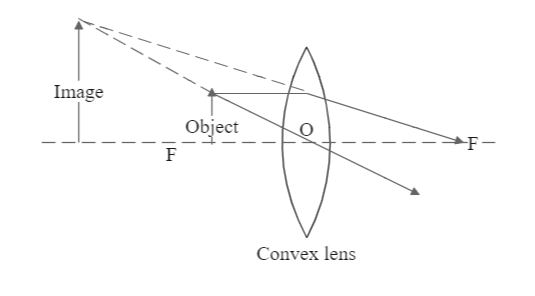
Answer
454.8k+ views
Hint
When the observer looks at any object through a lens, the light rays travelling from that object incident at different points depending upon the location of the object. This location is also responsible for the apparent increase or decrease in size of the image visible to the observer.
Complete step by step answer
A convex lens is also known as a converging lens, as the parallel light rays from an object passing through it tend to converge at its principal focus. It is thicker in the middle as compared to its sides.
According to the question, we place the object between the optical centre O and the Focus of the lens F as shown below:

Now to understand the image formation in this alignment, we draw light rays coming out of the object parallel to the principal axis. As the object is very close to the lens, this light ray gets refracted inside the lens and converges on the focus on the other side. Another light ray from the same point of the object will travel straight through the optical centre without any refraction. We can see that these two lines are divergent in nature. To find the point of image formation, we need to find the place where they converge.
So, we extend them backwards and see that they meet at a point on the same side of the lens as the object. We can also see that this enlarges the image as compared to the original size.
Hence, the correct answer is option (A).
Note
The converging convex lens, and the diverging concave lens are readily used for correcting eyesight. The convex lens is used for correcting far-sightedness or hypermetropia, while the concave lens is used for correcting short-sightedness or myopia.
When the observer looks at any object through a lens, the light rays travelling from that object incident at different points depending upon the location of the object. This location is also responsible for the apparent increase or decrease in size of the image visible to the observer.
Complete step by step answer
A convex lens is also known as a converging lens, as the parallel light rays from an object passing through it tend to converge at its principal focus. It is thicker in the middle as compared to its sides.
According to the question, we place the object between the optical centre O and the Focus of the lens F as shown below:

Now to understand the image formation in this alignment, we draw light rays coming out of the object parallel to the principal axis. As the object is very close to the lens, this light ray gets refracted inside the lens and converges on the focus on the other side. Another light ray from the same point of the object will travel straight through the optical centre without any refraction. We can see that these two lines are divergent in nature. To find the point of image formation, we need to find the place where they converge.
So, we extend them backwards and see that they meet at a point on the same side of the lens as the object. We can also see that this enlarges the image as compared to the original size.
Hence, the correct answer is option (A).
Note
The converging convex lens, and the diverging concave lens are readily used for correcting eyesight. The convex lens is used for correcting far-sightedness or hypermetropia, while the concave lens is used for correcting short-sightedness or myopia.
Recently Updated Pages
Identify the feminine gender noun from the given sentence class 10 english CBSE

Your club organized a blood donation camp in your city class 10 english CBSE

Choose the correct meaning of the idiomphrase from class 10 english CBSE

Identify the neuter gender noun from the given sentence class 10 english CBSE

Choose the word which best expresses the meaning of class 10 english CBSE

Choose the word which is closest to the opposite in class 10 english CBSE

Trending doubts
Which are the Top 10 Largest Countries of the World?

How do you graph the function fx 4x class 9 maths CBSE

Fill the blanks with the suitable prepositions 1 The class 9 english CBSE

Kaziranga National Park is famous for A Lion B Tiger class 10 social science CBSE

The Equation xxx + 2 is Satisfied when x is Equal to Class 10 Maths

Difference between Prokaryotic cell and Eukaryotic class 11 biology CBSE

Change the following sentences into negative and interrogative class 10 english CBSE

Give 10 examples for herbs , shrubs , climbers , creepers

Write a letter to the principal requesting him to grant class 10 english CBSE




